
Images By Tang Ming Tung/Getty Images
Many celebrations involve food in some way, shape, or form. But when food is the celebration, you know you’re in for a memorable experience. Food festivals and events have been a longstanding tradition around the world for centuries. They often feature a variety of cuisine and highlight specific restaurants or chefs within a region, like the NYC Food and Wine Festival. Some festivals, however, focus on a single theme, such as the National Fried Chicken Festival or the Gilroy Garlic Festival. While a city’s or country’s signature dish is often worthy of its own showcase, there are some lesser-known gastronomic gatherings that highlight unusual recipes and ingredients, with festivities that aren’t for the faint of heart.
In this list, we’ll explore food-focused events around the world, all with themes that venture into unusual, creative, and even downright weird territory. Some of these festivals honor time-honored culinary traditions, while others are more contemporary and whimsical, held in the spirit of blending fun with food. So, let’s get ready for food fights, humongous dishes, and even a bit of roadkill-grilling — don’t say we didn’t warn you — as we dive mouth-first into a world tour of the strange and delicious.
La Tomatina – Spain

Zowy Voeten/Getty Images
Arguably one of the most famous of all bizarre food-themed events around the world, La Tomatina, held in the town of Buñol, Spain, attracts thousands of tourists and locals for the biggest food fight on the planet. It all started back in 1945, when a group of unruly teenagers got into an argument during a costume parade and began throwing tomatoes at one another. The next annual parade was canceled, but the youths turned up regardless, armed with even more tomatoes. Eventually, locals began embracing the event, which over the years transformed into a joyous town-wide tradition. Now, every last Wednesday in August, participants gather in the town square and hurl tomatoes until everyone is literally red in the face.
Over 80 years later, La Tomatina sees 22,000 people come together from around the world to chuck over 120 tons of tomatoes at each other. Folks wear old clothes they don’t mind tossing away after the fight, sometimes donning bathing suits underneath for good measure. By the end of the event, everyone — soaked head-to-toe in bright red juice and shreds of tomato skin — heads off to drink, party, and revel in the fact they just took part in one of the world’s most unique food events.
Hokitika Wildfoods Festival – New Zealand

Kai Schwoerer/Getty Images
Every region of the world is home to unique native foods, and few are as distinct as those of the remote island nation, New Zealand. The country’s isolated location in the South Pacific gives it an incomparable biodiversity that yields ingredients worth celebrating. The Hokitika Wildfoods Festival does just this, with festivities honoring the traditional foods of New Zealand — specifically those of the West Coast — focusing on the strange and wonderful.
Every second Saturday in March, folks gather in Cass Square in Hokitika to celebrate their country’s cuisine, as well as the anniversary of Hokitika itself. The festival is filled with booths offering dishes made from ingredients native to the bush and waters of Western New Zealand. But don’t expect some tame veggies and boring stews; this event is all about unleashing your inner Kiwi with bugs and offal. We’re talking huhu grubs (juvenile beetles), lamb testicles, desserts made from ground-up wasps, and pig snout on a stick. Don’t worry, you can order the grubs barbecued, but be warned — they might still be wiggling.
Roadkill Cook-Off – USA
West Virginia has a certain stigma attached to it, and the Roadkill Cook-Off aims to make light of the stereotype in true Southern fashion — through food. The festival pokes fun at the state’s down-home reputation with dishes featuring squirrel, possum, groundhog, bear, snake…you get the picture. Folks gather in the town of Marlinton, West Virginia, to watch chefs prepare meats that you don’t often see on a barbeque grill.
Don’t worry — the animals used in these recipes weren’t actually found by the side of the road. Rather, all of the food at the Roadkill Cook-Off is made using native game meat from animals that could have met their demise on an average West Virginia country road. Participants dress to the nines in goofy costumes reflecting their country roots and name their dishes things like “Ma, them hogs are runnin’ wild in the pineapple!” to really drive the point home. Iron-stomached judges determine a winner, who takes home $1,200 and Marlinton’s highest culinary honor. The festival sometimes sees as many as 20,000 visitors, but only about 10% are usually willing to chow down on some teriyaki bear or snapping turtle stew.
Gloucestershire Cheese Rolling – England

Cameron Smith/Getty Images
Spring is the time to celebrate flowers blooming, lively forests full of baby critters, and — in Gloucestershire, England — cheese. The annual Cheese Rolling event is one of the world’s most infamous food-themed traditions. Every year, on England’s spring bank holiday, a wheel of Double Gloucester cheese is rolled down Cooper’s Hill, the steepest slope in the county. Festival participants aren’t required to register — they just need to appear on top of the hill the morning of the event and run after the cheese.
Now, when we say that event participants run after the cheese, what we really mean is that they tumble, fall, and somersault, given that the 180-meter hill has a 1:2 gradient. It really is a sight to behold. No one ever catches the cheese wheel, which sometimes reaches speeds of 80 miles per hour. Instead, the winner is the first one to cross the finish line. Britain’s Cheese Rolling contest is believed to have started as a method of settling land disputes in the early 19th century, but others believe the event is actually more than 600 years old. Today, despite having no official organizers and operating entirely at participants’ own risk, the contest hosts dozens of cheese chasers and thousands of onlookers every year.
Monkey Buffet Festival – Thailand
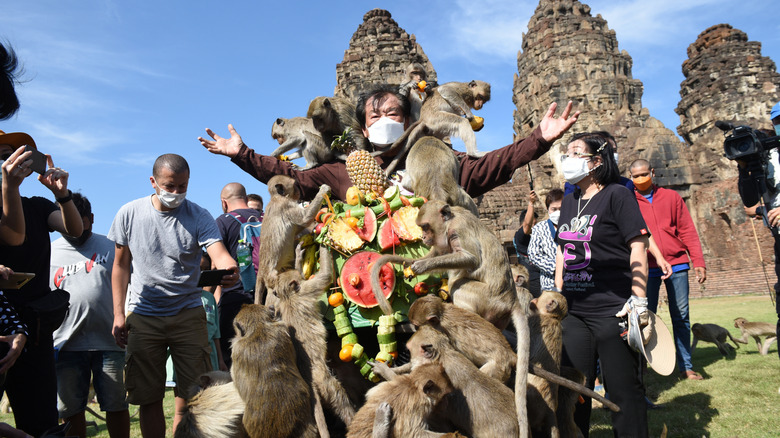
teera.noisakran/Shutterstock
We know the aforementioned Roadkill Cook-Off might have you wondering where this is going, but don’t fret — no monkeys are consumed at this event. On the contrary, the Monkey Buffet Festival of Lopburi, Thailand, centers around a colorful, ornate tower of fruits and vegetables at Phra Prang Sam Yot temple. The temple is a 13th-century site that provides a unique backdrop of ancient, rustic ruins against the beautiful bounty of fresh foods.
Before the ceremony, which takes place on the last Sunday of November, dancers dressed as monkeys entertain the (human) guests before a tower of food is unveiled. Then, thousands of macaques — a native primate — are allowed access to the tower, where they feast away to the delight of onlookers. This tradition stems from Thailand’s deep respect for macaques, who are thought to be an omen of prosperity and good fortune. The people of Lopburi think of this annual festival as their way of giving back to their primate friends and hopefully guaranteeing a little good luck down the road.
Giant Omelette Festival – France
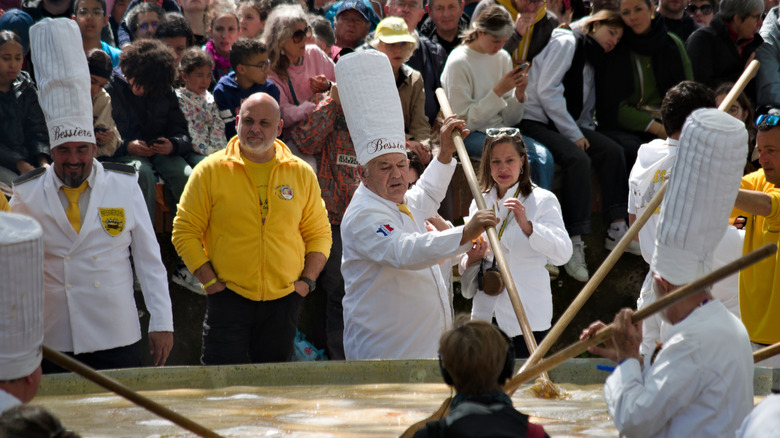
Nick Kozlov/Shutterstock
Easter is all about eggs in Bessières, France, but not in the way you’re thinking. Instead of hiding eggs in bushes and dyeing them with pastel colors, the folks of Bessières gather for an epic breakfast featuring a single gigantic omelette. The Giant Omelette Festival started in the 1970s and has continued annually, adding more eggs and extra festivities as the years march on. The three-day festival includes music, parades, and games but finishes out with the main event: feasting on a 15,000-egg omelette.
Chefs organized by the Brotherhood of the Giant Omelette (yes, that’s really what they’re called, and no, they’re not an egg-worshipping cult) gather in the town square to crack enough eggs for a French-style omelette that will feed over 2,000 people. Some claim the festival was inspired by a tale about Napoleon Bonaparte, who, while visiting the region, allegedly ordered an innkeeper to craft an omelette big enough to feed his entire army. Others say that the humongous dish is simply a way to demonstrate teamwork and celebrate the power food has to bring everyone together.
Testicle Festival – Midwestern United States
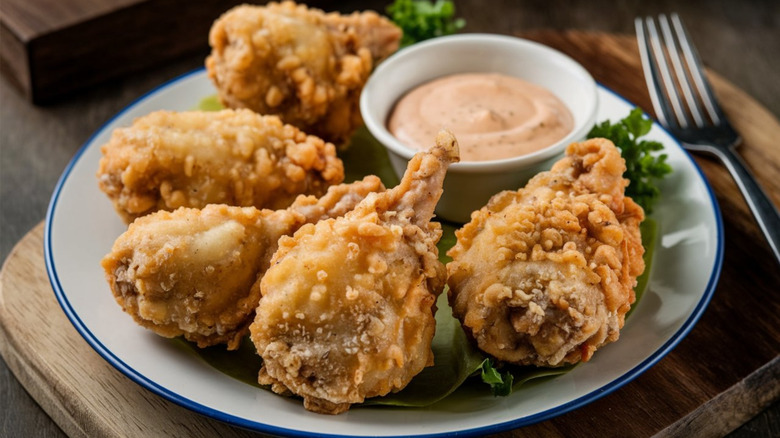
Sham Clicks/Shutterstock
The Testicle Festival, otherwise known as the Testy Festy, Festicle, or the Ball Ball (okay, we made that last one up), is a celebration of one particular organ meat. Bull and sheep testicles, known as Rocky Mountain oysters in the American Midwest, are something of a delicacy. Festivals are held throughout the Midwest — with a notable event held in Deerfield, Michigan — to celebrate this hilarious and surprisingly delicious dish, which usually involves battering and frying up the gonads and serving them with a dipping sauce.
Nowadays, there are small Festicles held all over the Midwest, but there was once a massive event held near Missoula, Montana, that will forever go down in infamy. This particular Testicle Festival was a whopping five days long and was known to attract ne’er-do-wells, who pitched tents in a literal swamp before indulging quite heavily in far more than just fried genitalia. The festival included tricycle races, questionably legal contests, and other debauchery that’s often the result of five straight days of heavy drinking. It was eventually shut down in 2017 after a series of fatal accidents, attempted murders, and arrests galore — who knew a humble set of gonads could be an agent of chaos?
Waikiki Spam Jam – Hawaii
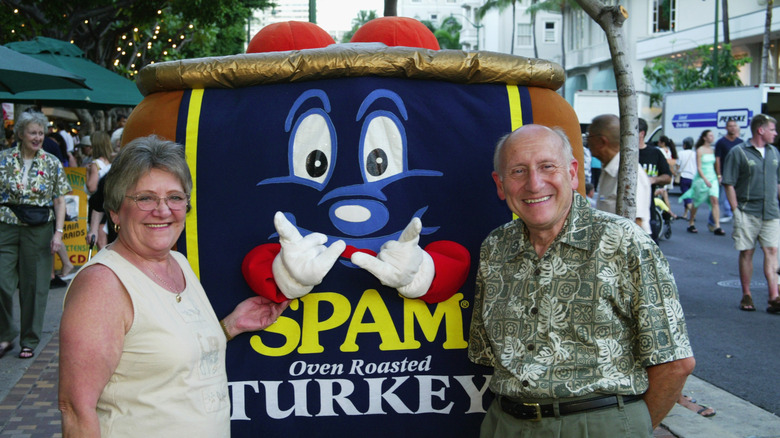
Phil Mislinski/Getty Images
To many of us, Spam is just salty processed ham in a can. However, in Hawaii, Spam is the cornerstone of a culinary identity. As remote as it is, getting fresh goods into the state is no small feat. The tinned meat became a beloved staple during World War II, and Spam is now found everywhere in Hawaii. It was infused with the island’s iconic Asian-inspired dishes, yielding a unique type of cuisine that’s whimsical, practical, and surprisingly delicious.
Springtime in Waikiki, a popular tourist destination in Honolulu, signifies the start of one of Hawaii’s biggest food festivals. It’s all about Spam during the Waikiki Spam Jam, which features Spam-themed knick-knacks and, obviously, plenty of Spam-centric fare. During the week of the event — a block party-style affair with craft vendors and food tents — restaurants all over the island feature Spam-based dishes on their menus to honor a product that few would assume could have such a significant influence on an entire population’s cuisine.
The Night of the Radishes – Mexico
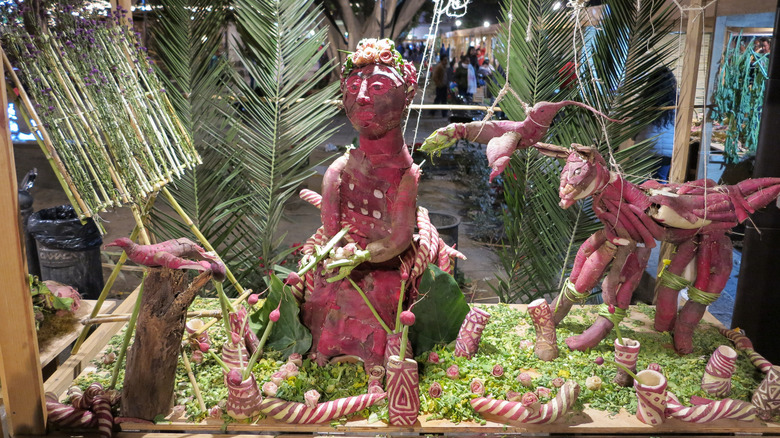
Just Another Photographer/Shutterstock
In the days leading up to Christmas, many families prepare for the holiday by decorating the Christmas tree, wrapping presents, and baking festive treats. But in Oaxaca, Mexico, the pre-Christmas tradition is an occasion of its own, and it involves radishes. A lot of radishes.
“Noche de Rábanos” — “Night of the Radishes” – takes place in the center of Oaxaca City on December 23 every year. Artists arrive early, radishes in tow, to set up their creations. They’ve labored away for hours in advance, crafting ornate sculptures depicting modern and ancient life in Oaxaca entirely from the root vegetable. The festival begins at 3 p.m., but many onlookers wait until nightfall before flooding the town square, when the radishes are lit up and looking their best. The festival is said to have started over 100 years ago, when an abundant radish crop meant many were harvested late. By the time they were dug up, the vegetables had become overgrown and deformed, inspiring some vendors to carve the radishes into unusual figures at the Christmas Eve Market. The carvings were a surprise hit and swiftly became a tradition that has evolved into one of the most unique festivals in the world.
World Egg Throwing Championship – England

Ian Melvin/Shutterstock
Instead of an egg fight à la La Tomatina (although that would be fun, too), the World Egg Throwing Championship of Lincolnshire, England, is a surprisingly structured contest. Teams of two travel to the village of Swaton from all over the world to throw and catch eggs at greater and greater distances until the egg inevitably splatters. The team that manages to throw and catch their egg over the greatest distance wins the championship title. Currently, the world record is held by a team from New Zealand, who achieved a distance of 309 feet back in 2016.
The sport — yes, it’s considered a real, bona fide sport in Lincolnshire — has roots dating all the way back to the 12th century. It supposedly began when the town’s monks started passing out eggs to residents to persuade them to attend church. However, the church lay across a river, and when the waters rose too high for parishioners to cross and restock their egg supply, the monks would throw the eggs across the river. The event, born out of necessity, was so fun that the tradition continues nearly 700 years later.
Battle of the Oranges – Italy
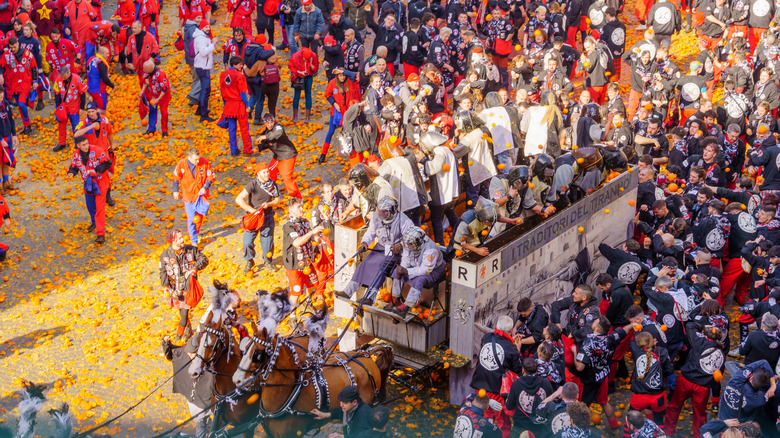
Rndms/Getty Images
One of Italy’s most popular pre-Lenten festivals is the historic Ivrea Carnival. The Carnival itself lasts a few days, but the festival period begins months earlier to celebrate the region’s history. Dating back to pre-Renaissance times, the Ivrea Carnival is the oldest festival still celebrated in the country. Among the revelry is one particularly iconic event: The Battle of the Oranges.
The Battle of the Oranges is exactly what it sounds like — festival participants gather and hurl oranges at one another. However, while it may sound like a cheeky, lighthearted game, it was actually inspired by a significant historical event. In the year 1200, the people of Ivrea supposedly overthrew their city’s tyrannical leader in a legendary rebellion that the city would never forget. Now, during Carnival, attendees reenact the uprising with teams of “rebels” on foot facing off against “the tyrant’s army” wearing armor and riding in horse-drawn carts. Instead of stones, the participants throw thousands of oranges at one another, turning the city into a delicious-smelling, sticky mess.
Maslenitsa Festival – Russia
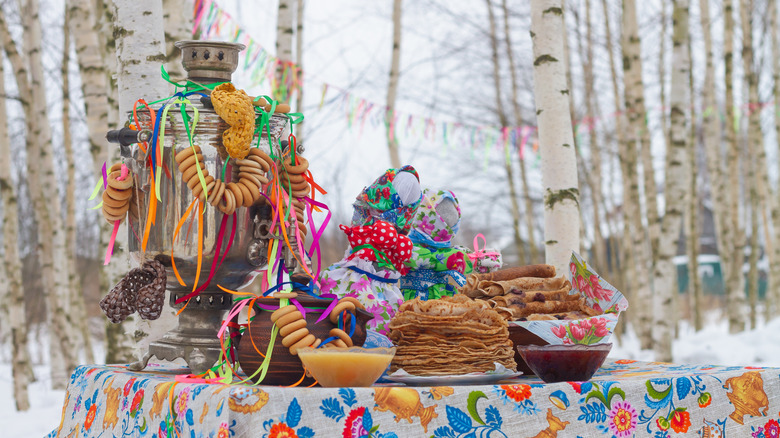
Olga Evtushkova/Getty Images
If there’s any food that deserves an entire week dedicated to it, pancakes are certainly a worthy contender. The Maslenitsa Festival is a celebration focused around Russian-style pancakes known as blini, which are topped and filled with both savory and sweet ingredients, including fish, sour cream, and fruit. Fusing Christian and Slavic folk traditions, Maslenitsa marks the last week before Lent and the end of winter, so a little gluttony isn’t frowned upon. Orthodox Russians are forbidden from consuming dairy during Lent, so blini — made with plenty of butter and milk — are the perfect indulgence, and the richer the toppings, the better.
The round, buttery pancakes are meant to represent the sun, whose arrival has been long-awaited after months of dark, cold winter. Along with the pancakes, Russians all around the country celebrate with parades, music, and games. Moscow alone hosts more than 500 separate Maslenitsa events across the city, so to say the tradition is popular would be an understatement.
Kaljakellunta – Finland
Drinking beer and relaxing might be just a regular weekend for some of us, but at Kaljakellunta they do it in a very particular way. The Finnish festival’s name roughly translates to “beer floating,” and that’s exactly what the event involves. Participants gather in inflatable tubes, boats, and even homemade rafts that would make MacGyver cringe. Then, they sip on beer while floating leisurely down the Vantaa River in the country’s Uusimaa province.
Like the Gloucestershire Cheese Rolling event, this floating-and-drinking festival has no official organizers, yet thousands still turn up to imbibe and cascade down the river. Legend has it that the first beer floaters were band members from a nearby rehearsal room, who decided to make their own raft and float down the river in 1997. It started with just 10 people, then doubled in size the following year, and has continued to grow. However, it should be said that there’s been quite a bit of pushback from the town’s residents, who don’t appreciate the cleanup involved after the event.
The Wine Fight – Spain

BearFotos/Shutterstock
It seems that the Spaniards really love their food fights. In Haro, Spain, locals and tourists alike gather to spray red wine all over one another in an event known simply as “La Batalla del Vino,” or “The Wine Fight.” Participants hike up a mountain on the outskirts of town to spray red wine at each other, typically using water guns. They dress in their best (okay, maybe not “best”) white clothes to let the brilliant purple hue of enemy fire shine boldly and proudly.
This event isn’t just about having a food fight; it’s also a time to celebrate the town’s winemaking history and honor St. Peter’s Feast Day, though the wine battle tends to overshadow the other festivities. There’s a good chance that some wine ends up in the participants’ systems, so after everyone’s been thoroughly doused, they head back down the mountain to party it up for the rest of the evening in the cozy, quintessential Spanish town.
Ugly Food Festival – Iceland
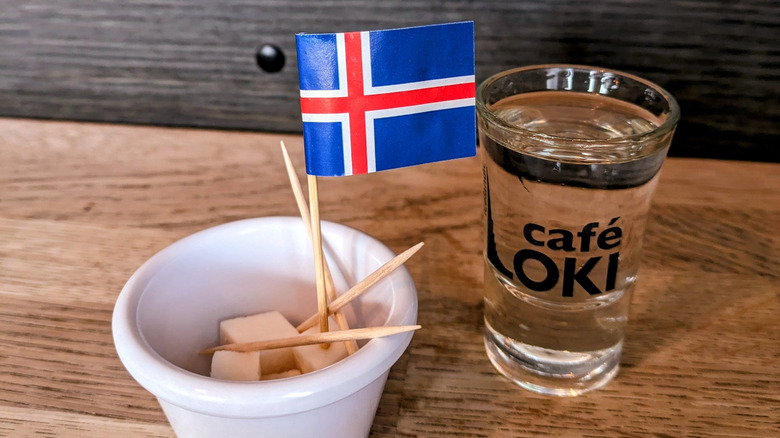
Roaming Swanny/Shutterstock
Icelandic food is known for being incredibly distinct and not always suitable for those with sensitive tastes. But for those with the opposite of a picky palate, Iceland’s Ugly Food Festival is calling. The event, celebrated all over the country, showcases some of the most iconic dishes made with native ingredients, particularly those lacking aesthetic appeal. We’re talking boiled sheep heads, liver pudding, pickled ram testicles, and hákarl — cubes of fermented shark that even Anthony Bourdain had to draw the line at.
The Ugly Foods Festival is based on ancient Norse traditions honoring Thor, the god of thunder, during the mid-winter season. The tradition died when the country converted to Christianity, but in the 1870s, Icelandic students living in Denmark revived the old practice. In addition to eating infamous dishes like hákarl, other — let’s just say, more approachable — recipes are enjoyed during the nationwide festival, like rye bread, herring, and dried fish.


Dining and Cooking